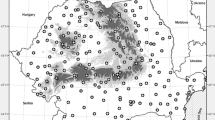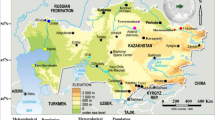Abstract
Air temperature and precipitation data observed and recorded by the Japan Meteorological Agency (JMA) from 1906 to 2005 were analyzed. Observed trends and correlations at 16 weather stations in urban and rural areas over Japan from Nemuro in the north (43.3oN) to Ishigaki in the south (24.3 N) were identified and quantified. Average annual values were emphasized in a previous analysis (Higashino and Stefan 2014). Herein monthly values and extreme events at the daily and hourly timescale were extracted and interpreted. As shown in 2014, observed air temperature rises are much larger in urban than in rural areas and are statistically significant at all sites. Air temperature rises in Japan in the period 1906–2005 are strongest in spring (March, April, and May) and weakest in midsummer (July and August). Monthly air temperature rises have accelerated over time by a factor of about 3 from the period (1906–2005) to (1981–2005), except for a short period in August. In the period (1906–2005), daily minimum air temperature rises have occurred at all sites. Daily and yearly minimum air temperature trends are more than twice as strong as daily and yearly maximum temperature trends. The numbers of annual hot days and hot nights have also increased at most of the study sites in the period (1906–2005), but only the number of hot nights and the daily minimum air temperature are strongly correlated with annual average air temperature increases. The trends in the annual numbers of frost days and hot nights are well correlated with the annual average air temperature trend, one negative, the other positive, as to be expected. Trends in mean annual precipitation are very small, near zero for (1906–2005), mostly negative for 1956–2005, and mostly positive for 1981–2005. There is no correlation with trends in air temperature. Daily maximum precipitation for (1906–2005) and (1956–2005) shows only small and often non-statistically significant changes at the 16 study sites. In (1981–2005), trends have increased significantly but fluctuate significantly between positive and negative trends.









Similar content being viewed by others
References
Choi Y, Jung H-S, Nam KY, Kwon WT (2003) Adjusting urban bias in the regional mean surface temperature series of South Korea, 1968–99. Int J Climatol 23:577–591
DeGaetano AT, Allen RJ (2002) Trends in twentieth-century temperature extremes across the United States. J Clim 15:3188–3205
Easterling DR, Meehl GA, Parmesan C, Changnon SA, Karl TR, Mearns LO (1997) Maximum and minimum temperature trends for the globe. Science 277:364–367
Fujibe F (1995) Temperature rising trends at Japanese cities during the last hundred years and their relationships with population, population increasing rates and daily temperature ranges. Pap Meteorol Geophys 46:35–55
Fujibe F (2009) Detection of urban warming in recent temperature trends in Japan. Int J Climatol 29:1811–1822
Fujibe F (2010) Urban warming in Japanese cities and its relation to climate change monitoring. Int J Climatol 31(2):162–173
Fujibe F (2015) Relationship between interannual variations of extreme hourly precipitation and air/sea-surface temperature in Japan, SOLA, 2015. Vol. 11:5–9. https://doi.org/10.2151/sola.2015-002
Griffiths GM, Chambers LE, Haylock MR, Manton MJ, Nicholls N, Baek H-J, Choi Y, della-Marta PM, Gosai A, Iga N, Lata R, Laurent V, Maitrepierre L, Nakamigawa H, Ouprasitwong N, Solofa D, Tahani L, Thuy DT, Tibig L, Trewin B, Vediapan K, Zhai P (2005) Change in mean temperature as a predictor of extreme temperature change in the Asia-Pacific region. Int J Climatol 25:1301–1330
Hale RC, Gallo KP, Owen TW, Loveland TR (2006) Land use/land cover change effects on temperature trends at U.S. Clim Normals Stations Geophys Res Lett 33:L11703. https://doi.org/10.1029/2006GL026358
Hansen J, Ruedy R, Sato M, Imhoff M, Lawrence W, Easterling D, Peterson T, Karl T (2001) A closer look at United States and global surface temperature change. J Geophys Res 106:23947–23963
Higashino M, Stefan HG (2014) Hydro-climatic change in Japan (1906–2005): impacts of global warming and urbanization. Air Soil Water Res 2014(7):19–34. https://doi.org/10.4137/ASWRS13632
Hua LJ, Ma ZG, Guo WD (2008) The impact of urbanization on air temperature across China. Theor Appl Climatol 93:179–194
IPCC (2007) Climate change 2007: the physical science basis. In: Solomon S, Qin D, Manning M, Chen Z, Marquis M, Averyt K, Tignor M, Miller HL (eds) Contribution of working group I to the fourth assessment report of the IPCC. Cambridge University Press, New York, p 1056
IPCC. (2013). Climate change 2013: the physical science basis. Contribution of Working Group I to the Fifth Assessment Report of the Intergovernmental Panel on Climate Change. Cambridge University Press, 1535 pp.
Japan Meteorological Agency. (2016). Climate change monitoring report 2015
Jones PD, Groisman PYA, Coughlan M, Plummer N, Wang W-C, Karl TR (1990) Assessment of urbanization effects in time series of surface air temperature over land. Nature 347:169–172
Jones PD, Lister DH, Li Q (2008) Urbanization effects in large scale temperature records, with an emphasis on China. J Geophys Res 113:D16122. https://doi.org/10.1029/2008JD009916
Karl TR, Jones PD, Knight RW, Kukla G, Plummer N, Razuvayev V, Gallo KP, Lindseay J, Charlson RJ, Peterson TC (1993) A new perspective on recent global warming: asymmetric trends of daily maximum and minimum temperature. Bull Am Meteorol Soc 74:1007–1023
Kataoka K, Matsumoto F, Ichinose T, Taniguchi M (2009) Urban warming trends in several large Asian cities over the last 100 years. Sci Total Environ 407:3112–3119
Kendall MG (1975) Rank correlation methods. Griffin, London
Kim Y-H, Baik J-J (2002) Maximum urban heat island intensity in Seoul. J Appl Meteorol 41:651–659
Koppen W(1936). Das geographisca System der Klimate, in: Handbuch “ der Klimatologie, edited by: Koppen, W. and Geiger, G., 1. C. “ Gebr, Borntraeger, 1–44
Kunkel KE, Easterling DR, Hubbard K, Redmond K (2004) Temporal variations in frost-free season in the United States: 1895–2000. Geophys Res Lett 31:L03201. https://doi.org/10.1029/2003GL018624
Lai W-L, Cheng W-L (2010) Air temperature change due to human activities in Taiwan for the past century. Int J Climatol 30:432–444
Li Q, Zhang H, Liu X, Huang J (2004) Urban heat island effect on annual mean temperature during the last 50 years in China. Theor Appl Climatol 79:165–174
Lim Y-K, Cai M, Kalnay E, Zhou L (2005) Observational evidence of sensitivity of surface climate changes to land types and urbanization. Geophys Res Lett 32:L22712. https://doi.org/10.1029/2005GL024267
Liu X, Yin Z, Shao X, Qin N (2006) Temporal trends and variability of daily maximum and minimum, extreme temperature events, and growing season length over the eastern and central Tibetan Plateau during 1961–2003. J Geophys Res 111:D19109. https://doi.org/10.1029/2005JD006915
Mann HB (1945) Nonparametric tests against trend. Econometrica 13:245–259
NOAA (2015). National overview- October 2015 www.ncdc.noaa.gov/sotc/national/201510. Accessed 17 Jan 2020
Parker DE (2006) A demonstration that large-scale warming is not urban. J Clim 19:2882–2895
Parker DE (2010) Urban heat island effects on estimates of observed climate change. Climate Change 1:123–133
Pepin NC, Seidel DJ (2005) A global comparison of surface and free air temperatures at high elevations. J Geophys Res 110:D03104. https://doi.org/10.1029/2004JD005047
Peterson TC (2003) Assessment of urban versus rural in situ surface temperatures in the contiguous United States: no difference found. J Clim 16:2941–2959
Peterson TC, Owen TW (2005) Urban heat island assessment: metadata are important. J Clim 18:2637–2646
Peterson TC, Gallo KP, Lawrimore J, Huang A, McKittrick DA (1999) Global rural temperature trends. Geophys Res Lett 26:329–332
Ren G, Chu Z, Zhou J, Zhou Y, Zhang A, Guo J, Liu X (2008) Urbanization effects on observed surface air temperature trends in North China. J Clim 21:1333–1348
Ryoo SB, Kwon WT, Jhun JG (2004) Characteristics of wintertime daily and extreme minimum temperature over South Korea. Int J Climatol 24:145–160
Spearman C (1904) The proof and measurement of association between two things. Am J Psychol 15(1):72–101. https://doi.org/10.2307/1412159
Zhou L, Dickinson RE, Tian Y, Fang J, Li Q, Kaufmann RK, Tucker CJ, Myneni RB (2004) Evidence for a significant urbanization effect on climate in China. Proc Natl Acad Sci 101:9540–9544
Acknowledgments
The authors are grateful to Masaru Hirose, Mechanical and Environmental Systems Engineering, National Institute of Technology, Oita College, for his effort.
Author information
Authors and Affiliations
Corresponding author
Additional information
Publisher’s note
Springer Nature remains neutral with regard to jurisdictional claims in published maps and institutional affiliations.
Rights and permissions
About this article
Cite this article
Higashino, M., Stefan, H.G. Trends and correlations in recent air temperature and precipitation observations across Japan (1906–2005). Theor Appl Climatol 140, 517–531 (2020). https://doi.org/10.1007/s00704-020-03097-4
Received:
Accepted:
Published:
Issue Date:
DOI: https://doi.org/10.1007/s00704-020-03097-4




